Health Variations : Crohn’s Disease
VerifiedAdded on 2022/09/06
|7
|1825
|16
AI Summary
Contribute Materials
Your contribution can guide someone’s learning journey. Share your
documents today.
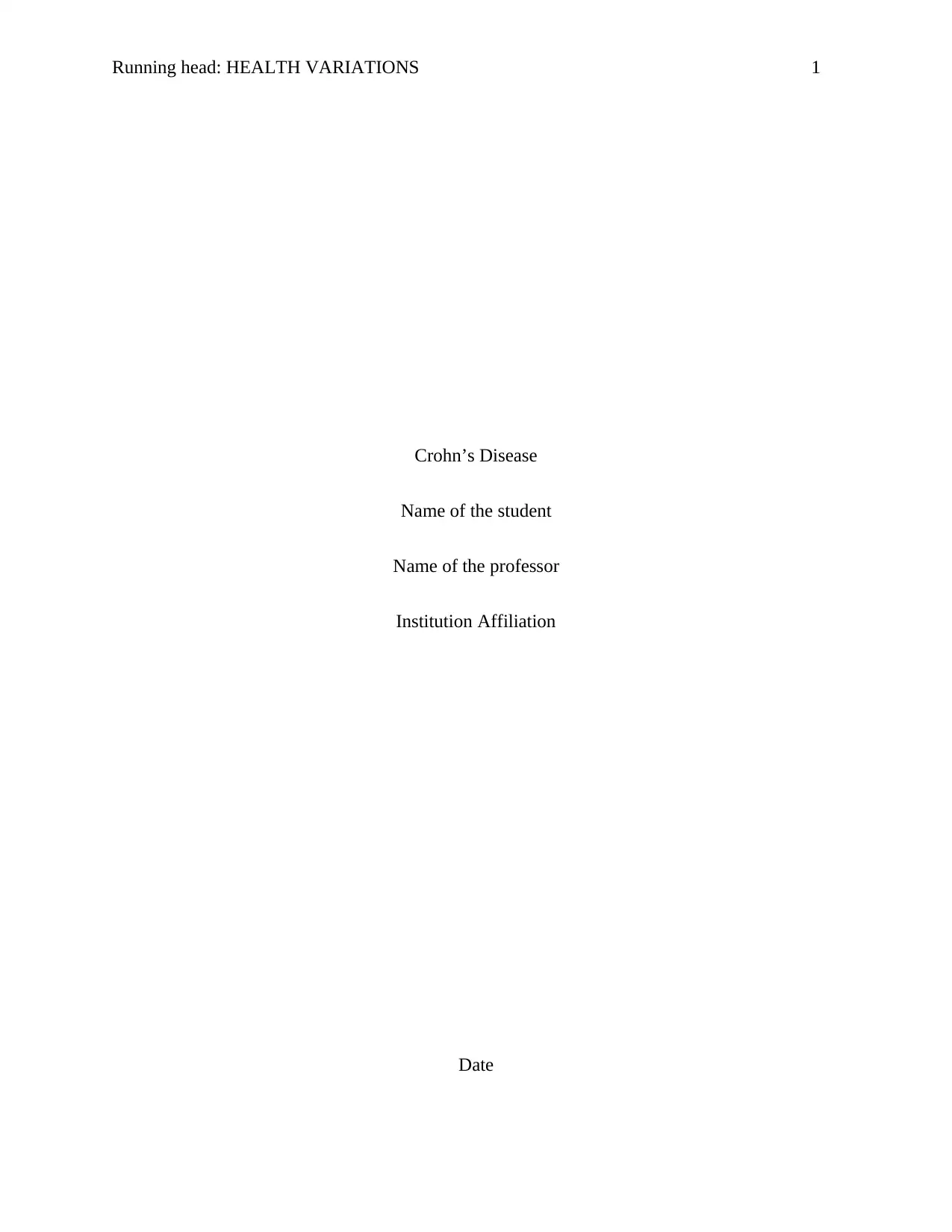
Running head: HEALTH VARIATIONS 1
Crohn’s Disease
Name of the student
Name of the professor
Institution Affiliation
Date
Crohn’s Disease
Name of the student
Name of the professor
Institution Affiliation
Date
Secure Best Marks with AI Grader
Need help grading? Try our AI Grader for instant feedback on your assignments.
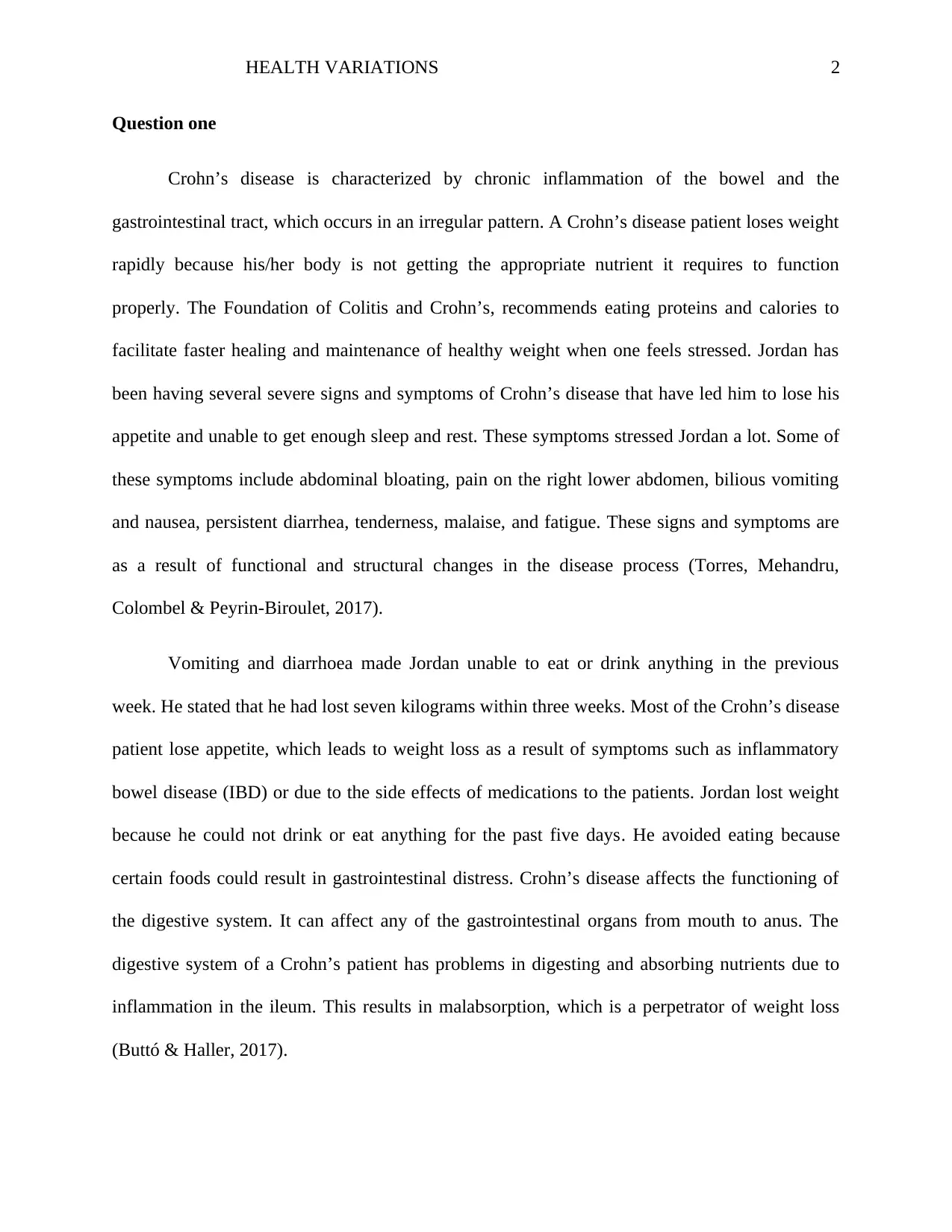
HEALTH VARIATIONS 2
Question one
Crohn’s disease is characterized by chronic inflammation of the bowel and the
gastrointestinal tract, which occurs in an irregular pattern. A Crohn’s disease patient loses weight
rapidly because his/her body is not getting the appropriate nutrient it requires to function
properly. The Foundation of Colitis and Crohn’s, recommends eating proteins and calories to
facilitate faster healing and maintenance of healthy weight when one feels stressed. Jordan has
been having several severe signs and symptoms of Crohn’s disease that have led him to lose his
appetite and unable to get enough sleep and rest. These symptoms stressed Jordan a lot. Some of
these symptoms include abdominal bloating, pain on the right lower abdomen, bilious vomiting
and nausea, persistent diarrhea, tenderness, malaise, and fatigue. These signs and symptoms are
as a result of functional and structural changes in the disease process (Torres, Mehandru,
Colombel & Peyrin-Biroulet, 2017).
Vomiting and diarrhoea made Jordan unable to eat or drink anything in the previous
week. He stated that he had lost seven kilograms within three weeks. Most of the Crohn’s disease
patient lose appetite, which leads to weight loss as a result of symptoms such as inflammatory
bowel disease (IBD) or due to the side effects of medications to the patients. Jordan lost weight
because he could not drink or eat anything for the past five days. He avoided eating because
certain foods could result in gastrointestinal distress. Crohn’s disease affects the functioning of
the digestive system. It can affect any of the gastrointestinal organs from mouth to anus. The
digestive system of a Crohn’s patient has problems in digesting and absorbing nutrients due to
inflammation in the ileum. This results in malabsorption, which is a perpetrator of weight loss
(Buttó & Haller, 2017).
Question one
Crohn’s disease is characterized by chronic inflammation of the bowel and the
gastrointestinal tract, which occurs in an irregular pattern. A Crohn’s disease patient loses weight
rapidly because his/her body is not getting the appropriate nutrient it requires to function
properly. The Foundation of Colitis and Crohn’s, recommends eating proteins and calories to
facilitate faster healing and maintenance of healthy weight when one feels stressed. Jordan has
been having several severe signs and symptoms of Crohn’s disease that have led him to lose his
appetite and unable to get enough sleep and rest. These symptoms stressed Jordan a lot. Some of
these symptoms include abdominal bloating, pain on the right lower abdomen, bilious vomiting
and nausea, persistent diarrhea, tenderness, malaise, and fatigue. These signs and symptoms are
as a result of functional and structural changes in the disease process (Torres, Mehandru,
Colombel & Peyrin-Biroulet, 2017).
Vomiting and diarrhoea made Jordan unable to eat or drink anything in the previous
week. He stated that he had lost seven kilograms within three weeks. Most of the Crohn’s disease
patient lose appetite, which leads to weight loss as a result of symptoms such as inflammatory
bowel disease (IBD) or due to the side effects of medications to the patients. Jordan lost weight
because he could not drink or eat anything for the past five days. He avoided eating because
certain foods could result in gastrointestinal distress. Crohn’s disease affects the functioning of
the digestive system. It can affect any of the gastrointestinal organs from mouth to anus. The
digestive system of a Crohn’s patient has problems in digesting and absorbing nutrients due to
inflammation in the ileum. This results in malabsorption, which is a perpetrator of weight loss
(Buttó & Haller, 2017).
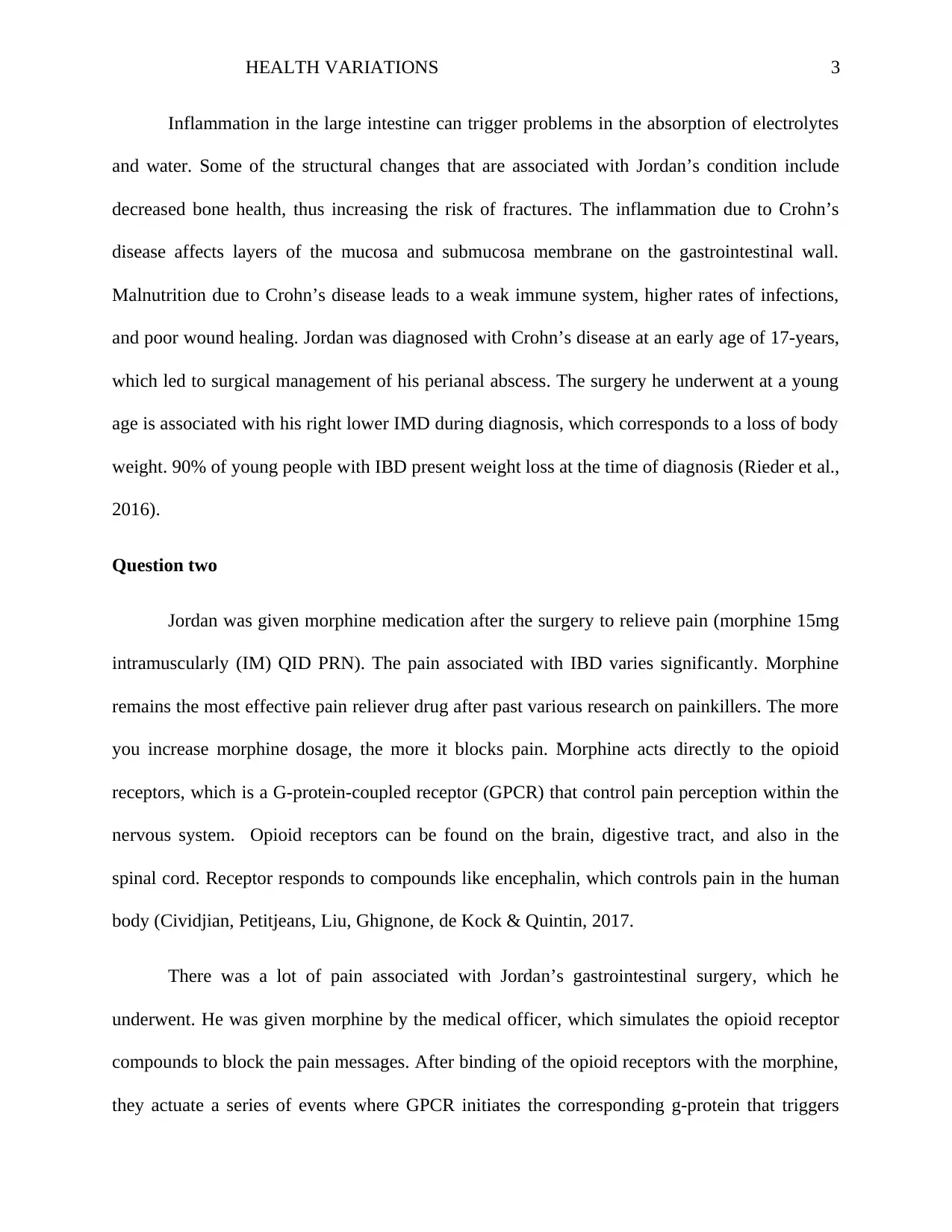
HEALTH VARIATIONS 3
Inflammation in the large intestine can trigger problems in the absorption of electrolytes
and water. Some of the structural changes that are associated with Jordan’s condition include
decreased bone health, thus increasing the risk of fractures. The inflammation due to Crohn’s
disease affects layers of the mucosa and submucosa membrane on the gastrointestinal wall.
Malnutrition due to Crohn’s disease leads to a weak immune system, higher rates of infections,
and poor wound healing. Jordan was diagnosed with Crohn’s disease at an early age of 17-years,
which led to surgical management of his perianal abscess. The surgery he underwent at a young
age is associated with his right lower IMD during diagnosis, which corresponds to a loss of body
weight. 90% of young people with IBD present weight loss at the time of diagnosis (Rieder et al.,
2016).
Question two
Jordan was given morphine medication after the surgery to relieve pain (morphine 15mg
intramuscularly (IM) QID PRN). The pain associated with IBD varies significantly. Morphine
remains the most effective pain reliever drug after past various research on painkillers. The more
you increase morphine dosage, the more it blocks pain. Morphine acts directly to the opioid
receptors, which is a G-protein-coupled receptor (GPCR) that control pain perception within the
nervous system. Opioid receptors can be found on the brain, digestive tract, and also in the
spinal cord. Receptor responds to compounds like encephalin, which controls pain in the human
body (Cividjian, Petitjeans, Liu, Ghignone, de Kock & Quintin, 2017.
There was a lot of pain associated with Jordan’s gastrointestinal surgery, which he
underwent. He was given morphine by the medical officer, which simulates the opioid receptor
compounds to block the pain messages. After binding of the opioid receptors with the morphine,
they actuate a series of events where GPCR initiates the corresponding g-protein that triggers
Inflammation in the large intestine can trigger problems in the absorption of electrolytes
and water. Some of the structural changes that are associated with Jordan’s condition include
decreased bone health, thus increasing the risk of fractures. The inflammation due to Crohn’s
disease affects layers of the mucosa and submucosa membrane on the gastrointestinal wall.
Malnutrition due to Crohn’s disease leads to a weak immune system, higher rates of infections,
and poor wound healing. Jordan was diagnosed with Crohn’s disease at an early age of 17-years,
which led to surgical management of his perianal abscess. The surgery he underwent at a young
age is associated with his right lower IMD during diagnosis, which corresponds to a loss of body
weight. 90% of young people with IBD present weight loss at the time of diagnosis (Rieder et al.,
2016).
Question two
Jordan was given morphine medication after the surgery to relieve pain (morphine 15mg
intramuscularly (IM) QID PRN). The pain associated with IBD varies significantly. Morphine
remains the most effective pain reliever drug after past various research on painkillers. The more
you increase morphine dosage, the more it blocks pain. Morphine acts directly to the opioid
receptors, which is a G-protein-coupled receptor (GPCR) that control pain perception within the
nervous system. Opioid receptors can be found on the brain, digestive tract, and also in the
spinal cord. Receptor responds to compounds like encephalin, which controls pain in the human
body (Cividjian, Petitjeans, Liu, Ghignone, de Kock & Quintin, 2017.
There was a lot of pain associated with Jordan’s gastrointestinal surgery, which he
underwent. He was given morphine by the medical officer, which simulates the opioid receptor
compounds to block the pain messages. After binding of the opioid receptors with the morphine,
they actuate a series of events where GPCR initiates the corresponding g-protein that triggers
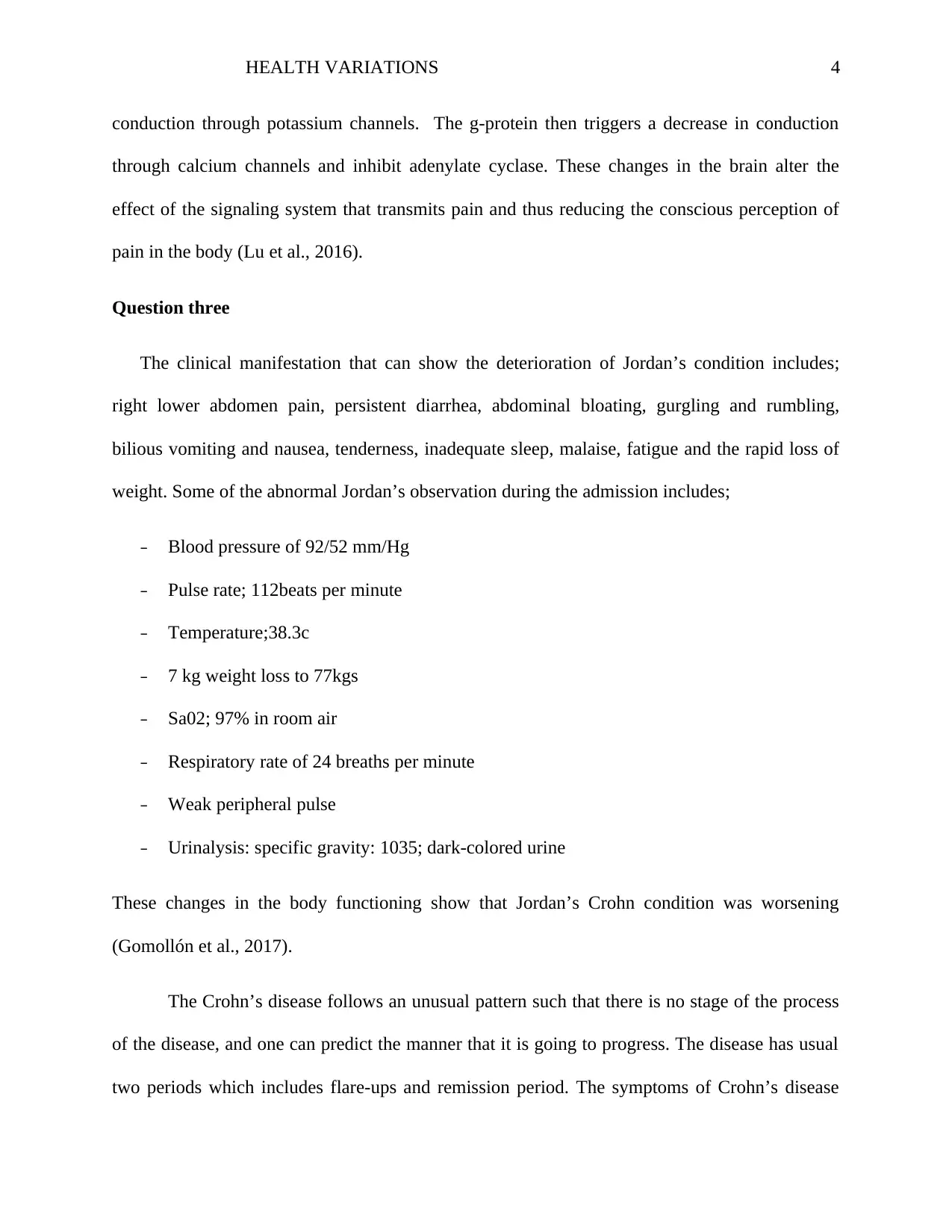
HEALTH VARIATIONS 4
conduction through potassium channels. The g-protein then triggers a decrease in conduction
through calcium channels and inhibit adenylate cyclase. These changes in the brain alter the
effect of the signaling system that transmits pain and thus reducing the conscious perception of
pain in the body (Lu et al., 2016).
Question three
The clinical manifestation that can show the deterioration of Jordan’s condition includes;
right lower abdomen pain, persistent diarrhea, abdominal bloating, gurgling and rumbling,
bilious vomiting and nausea, tenderness, inadequate sleep, malaise, fatigue and the rapid loss of
weight. Some of the abnormal Jordan’s observation during the admission includes;
– Blood pressure of 92/52 mm/Hg
– Pulse rate; 112beats per minute
– Temperature;38.3c
– 7 kg weight loss to 77kgs
– Sa02; 97% in room air
– Respiratory rate of 24 breaths per minute
– Weak peripheral pulse
– Urinalysis: specific gravity: 1035; dark-colored urine
These changes in the body functioning show that Jordan’s Crohn condition was worsening
(Gomollón et al., 2017).
The Crohn’s disease follows an unusual pattern such that there is no stage of the process
of the disease, and one can predict the manner that it is going to progress. The disease has usual
two periods which includes flare-ups and remission period. The symptoms of Crohn’s disease
conduction through potassium channels. The g-protein then triggers a decrease in conduction
through calcium channels and inhibit adenylate cyclase. These changes in the brain alter the
effect of the signaling system that transmits pain and thus reducing the conscious perception of
pain in the body (Lu et al., 2016).
Question three
The clinical manifestation that can show the deterioration of Jordan’s condition includes;
right lower abdomen pain, persistent diarrhea, abdominal bloating, gurgling and rumbling,
bilious vomiting and nausea, tenderness, inadequate sleep, malaise, fatigue and the rapid loss of
weight. Some of the abnormal Jordan’s observation during the admission includes;
– Blood pressure of 92/52 mm/Hg
– Pulse rate; 112beats per minute
– Temperature;38.3c
– 7 kg weight loss to 77kgs
– Sa02; 97% in room air
– Respiratory rate of 24 breaths per minute
– Weak peripheral pulse
– Urinalysis: specific gravity: 1035; dark-colored urine
These changes in the body functioning show that Jordan’s Crohn condition was worsening
(Gomollón et al., 2017).
The Crohn’s disease follows an unusual pattern such that there is no stage of the process
of the disease, and one can predict the manner that it is going to progress. The disease has usual
two periods which includes flare-ups and remission period. The symptoms of Crohn’s disease
Secure Best Marks with AI Grader
Need help grading? Try our AI Grader for instant feedback on your assignments.
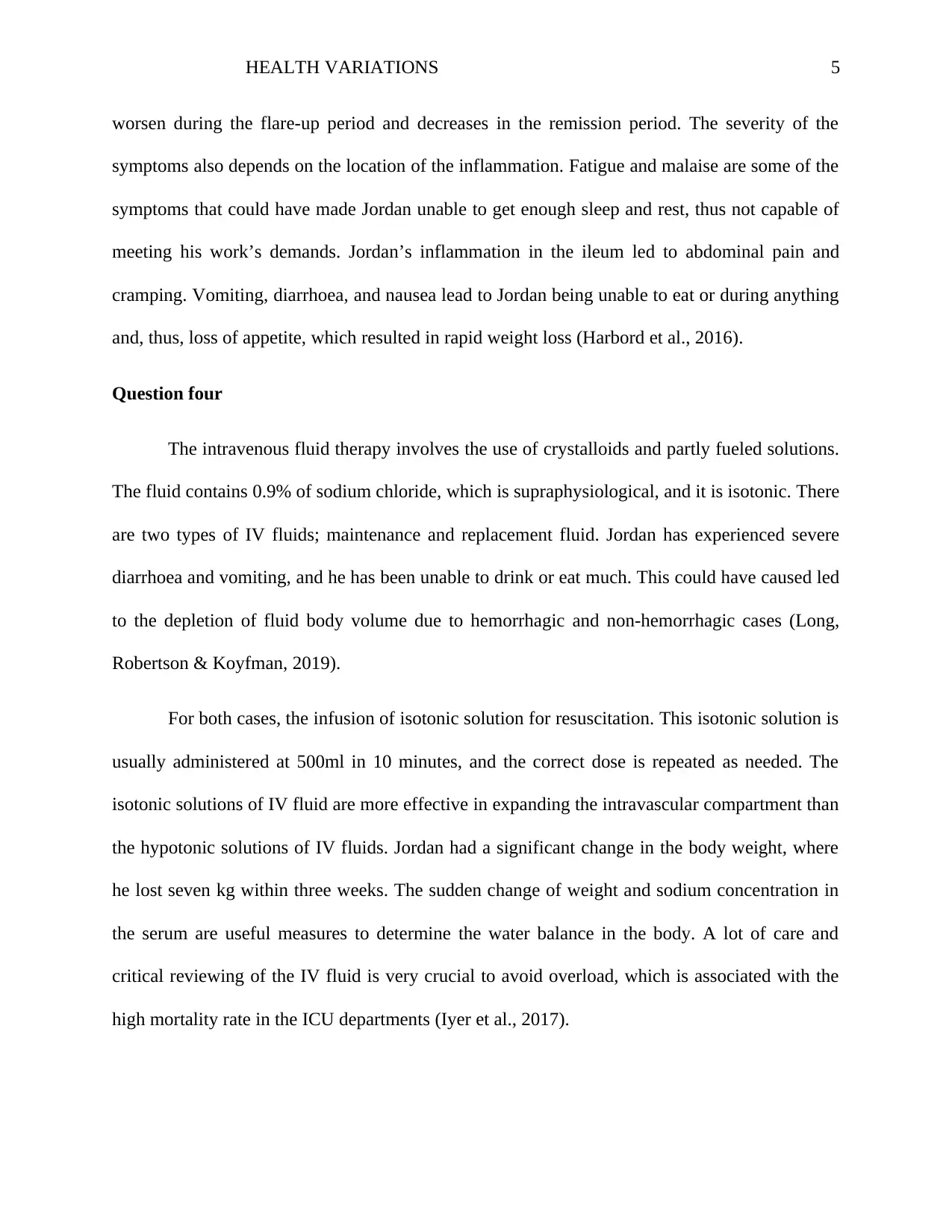
HEALTH VARIATIONS 5
worsen during the flare-up period and decreases in the remission period. The severity of the
symptoms also depends on the location of the inflammation. Fatigue and malaise are some of the
symptoms that could have made Jordan unable to get enough sleep and rest, thus not capable of
meeting his work’s demands. Jordan’s inflammation in the ileum led to abdominal pain and
cramping. Vomiting, diarrhoea, and nausea lead to Jordan being unable to eat or during anything
and, thus, loss of appetite, which resulted in rapid weight loss (Harbord et al., 2016).
Question four
The intravenous fluid therapy involves the use of crystalloids and partly fueled solutions.
The fluid contains 0.9% of sodium chloride, which is supraphysiological, and it is isotonic. There
are two types of IV fluids; maintenance and replacement fluid. Jordan has experienced severe
diarrhoea and vomiting, and he has been unable to drink or eat much. This could have caused led
to the depletion of fluid body volume due to hemorrhagic and non-hemorrhagic cases (Long,
Robertson & Koyfman, 2019).
For both cases, the infusion of isotonic solution for resuscitation. This isotonic solution is
usually administered at 500ml in 10 minutes, and the correct dose is repeated as needed. The
isotonic solutions of IV fluid are more effective in expanding the intravascular compartment than
the hypotonic solutions of IV fluids. Jordan had a significant change in the body weight, where
he lost seven kg within three weeks. The sudden change of weight and sodium concentration in
the serum are useful measures to determine the water balance in the body. A lot of care and
critical reviewing of the IV fluid is very crucial to avoid overload, which is associated with the
high mortality rate in the ICU departments (Iyer et al., 2017).
worsen during the flare-up period and decreases in the remission period. The severity of the
symptoms also depends on the location of the inflammation. Fatigue and malaise are some of the
symptoms that could have made Jordan unable to get enough sleep and rest, thus not capable of
meeting his work’s demands. Jordan’s inflammation in the ileum led to abdominal pain and
cramping. Vomiting, diarrhoea, and nausea lead to Jordan being unable to eat or during anything
and, thus, loss of appetite, which resulted in rapid weight loss (Harbord et al., 2016).
Question four
The intravenous fluid therapy involves the use of crystalloids and partly fueled solutions.
The fluid contains 0.9% of sodium chloride, which is supraphysiological, and it is isotonic. There
are two types of IV fluids; maintenance and replacement fluid. Jordan has experienced severe
diarrhoea and vomiting, and he has been unable to drink or eat much. This could have caused led
to the depletion of fluid body volume due to hemorrhagic and non-hemorrhagic cases (Long,
Robertson & Koyfman, 2019).
For both cases, the infusion of isotonic solution for resuscitation. This isotonic solution is
usually administered at 500ml in 10 minutes, and the correct dose is repeated as needed. The
isotonic solutions of IV fluid are more effective in expanding the intravascular compartment than
the hypotonic solutions of IV fluids. Jordan had a significant change in the body weight, where
he lost seven kg within three weeks. The sudden change of weight and sodium concentration in
the serum are useful measures to determine the water balance in the body. A lot of care and
critical reviewing of the IV fluid is very crucial to avoid overload, which is associated with the
high mortality rate in the ICU departments (Iyer et al., 2017).
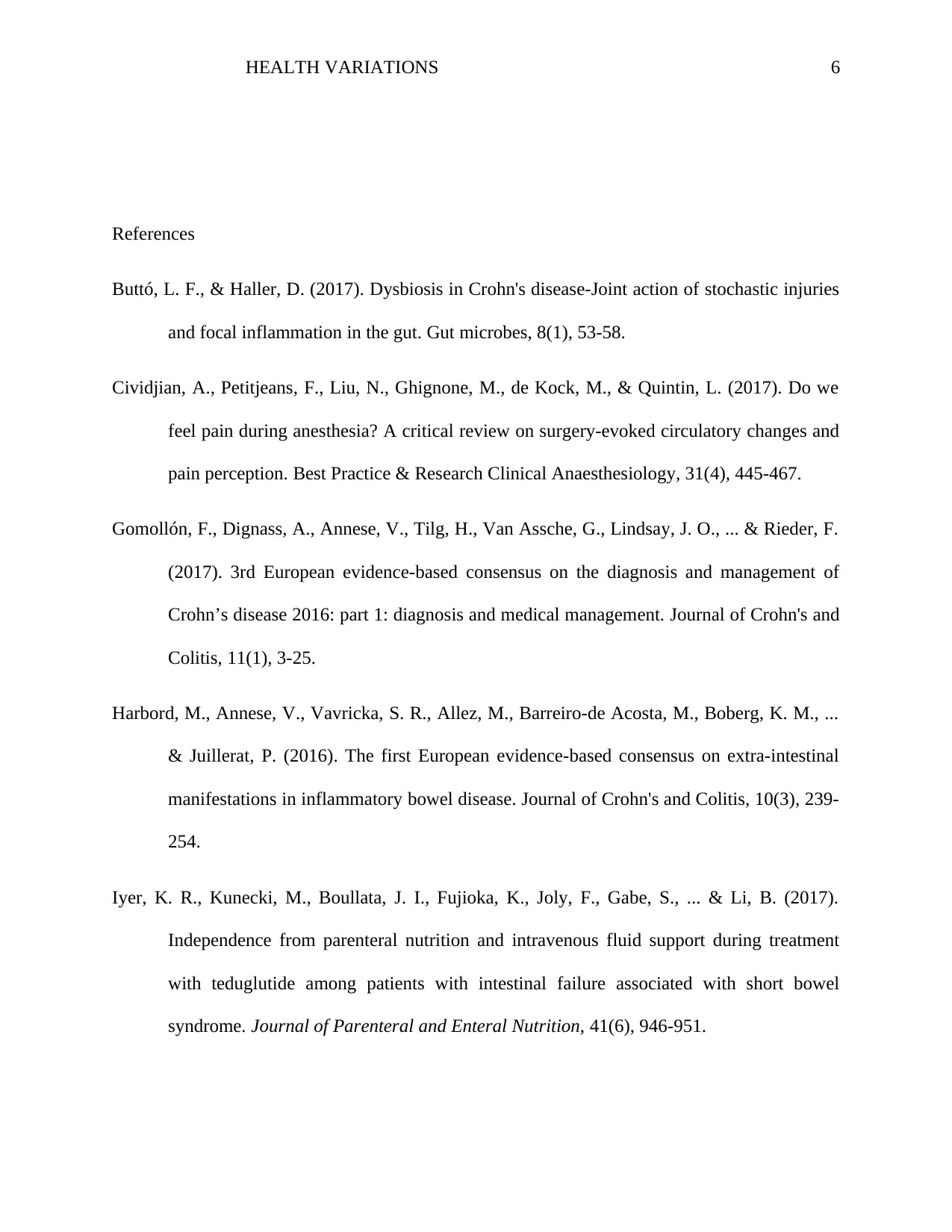
HEALTH VARIATIONS 6
References
Buttó, L. F., & Haller, D. (2017). Dysbiosis in Crohn's disease-Joint action of stochastic injuries
and focal inflammation in the gut. Gut microbes, 8(1), 53-58.
Cividjian, A., Petitjeans, F., Liu, N., Ghignone, M., de Kock, M., & Quintin, L. (2017). Do we
feel pain during anesthesia? A critical review on surgery-evoked circulatory changes and
pain perception. Best Practice & Research Clinical Anaesthesiology, 31(4), 445-467.
Gomollón, F., Dignass, A., Annese, V., Tilg, H., Van Assche, G., Lindsay, J. O., ... & Rieder, F.
(2017). 3rd European evidence-based consensus on the diagnosis and management of
Crohn’s disease 2016: part 1: diagnosis and medical management. Journal of Crohn's and
Colitis, 11(1), 3-25.
Harbord, M., Annese, V., Vavricka, S. R., Allez, M., Barreiro-de Acosta, M., Boberg, K. M., ...
& Juillerat, P. (2016). The first European evidence-based consensus on extra-intestinal
manifestations in inflammatory bowel disease. Journal of Crohn's and Colitis, 10(3), 239-
254.
Iyer, K. R., Kunecki, M., Boullata, J. I., Fujioka, K., Joly, F., Gabe, S., ... & Li, B. (2017).
Independence from parenteral nutrition and intravenous fluid support during treatment
with teduglutide among patients with intestinal failure associated with short bowel
syndrome. Journal of Parenteral and Enteral Nutrition, 41(6), 946-951.
References
Buttó, L. F., & Haller, D. (2017). Dysbiosis in Crohn's disease-Joint action of stochastic injuries
and focal inflammation in the gut. Gut microbes, 8(1), 53-58.
Cividjian, A., Petitjeans, F., Liu, N., Ghignone, M., de Kock, M., & Quintin, L. (2017). Do we
feel pain during anesthesia? A critical review on surgery-evoked circulatory changes and
pain perception. Best Practice & Research Clinical Anaesthesiology, 31(4), 445-467.
Gomollón, F., Dignass, A., Annese, V., Tilg, H., Van Assche, G., Lindsay, J. O., ... & Rieder, F.
(2017). 3rd European evidence-based consensus on the diagnosis and management of
Crohn’s disease 2016: part 1: diagnosis and medical management. Journal of Crohn's and
Colitis, 11(1), 3-25.
Harbord, M., Annese, V., Vavricka, S. R., Allez, M., Barreiro-de Acosta, M., Boberg, K. M., ...
& Juillerat, P. (2016). The first European evidence-based consensus on extra-intestinal
manifestations in inflammatory bowel disease. Journal of Crohn's and Colitis, 10(3), 239-
254.
Iyer, K. R., Kunecki, M., Boullata, J. I., Fujioka, K., Joly, F., Gabe, S., ... & Li, B. (2017).
Independence from parenteral nutrition and intravenous fluid support during treatment
with teduglutide among patients with intestinal failure associated with short bowel
syndrome. Journal of Parenteral and Enteral Nutrition, 41(6), 946-951.
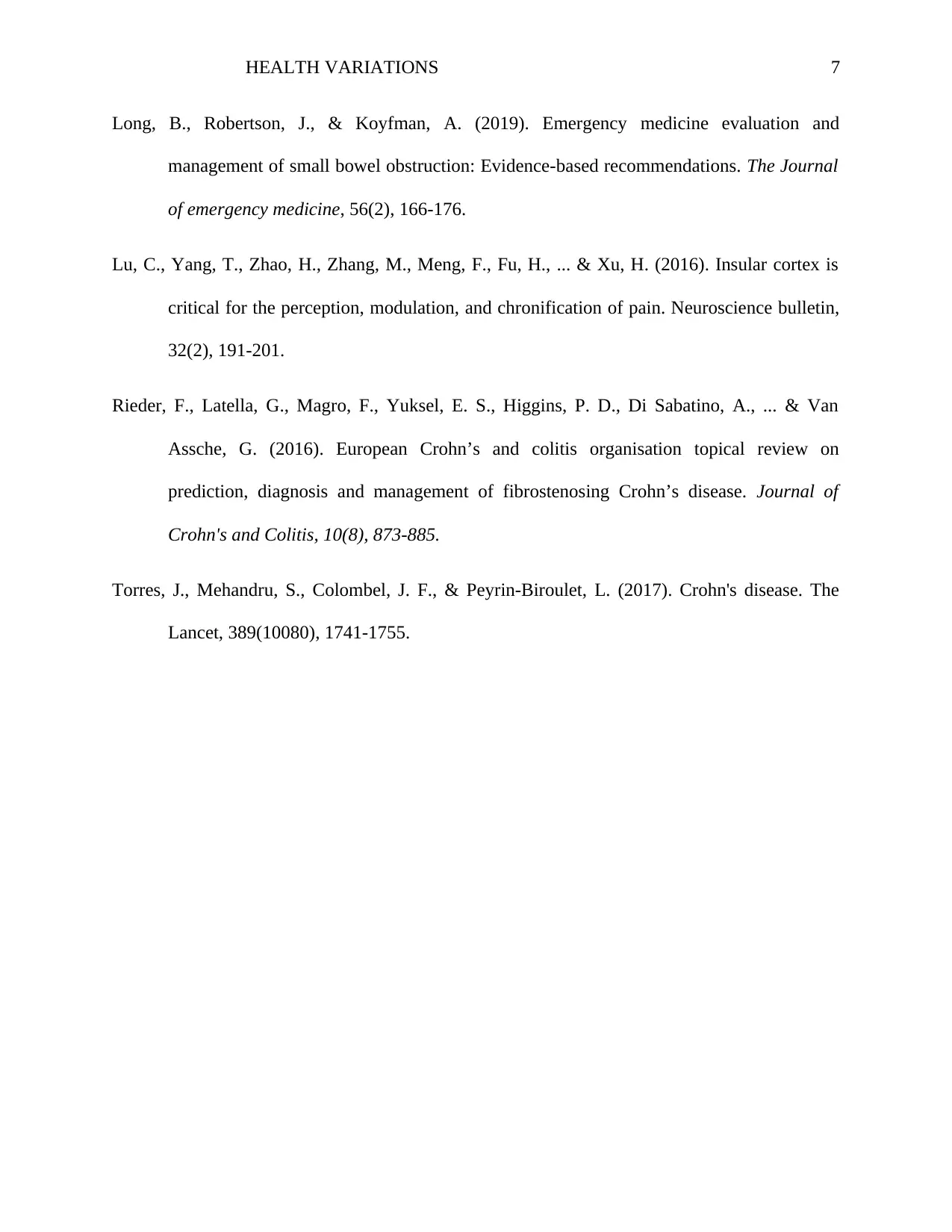
HEALTH VARIATIONS 7
Long, B., Robertson, J., & Koyfman, A. (2019). Emergency medicine evaluation and
management of small bowel obstruction: Evidence-based recommendations. The Journal
of emergency medicine, 56(2), 166-176.
Lu, C., Yang, T., Zhao, H., Zhang, M., Meng, F., Fu, H., ... & Xu, H. (2016). Insular cortex is
critical for the perception, modulation, and chronification of pain. Neuroscience bulletin,
32(2), 191-201.
Rieder, F., Latella, G., Magro, F., Yuksel, E. S., Higgins, P. D., Di Sabatino, A., ... & Van
Assche, G. (2016). European Crohn’s and colitis organisation topical review on
prediction, diagnosis and management of fibrostenosing Crohn’s disease. Journal of
Crohn's and Colitis, 10(8), 873-885.
Torres, J., Mehandru, S., Colombel, J. F., & Peyrin-Biroulet, L. (2017). Crohn's disease. The
Lancet, 389(10080), 1741-1755.
Long, B., Robertson, J., & Koyfman, A. (2019). Emergency medicine evaluation and
management of small bowel obstruction: Evidence-based recommendations. The Journal
of emergency medicine, 56(2), 166-176.
Lu, C., Yang, T., Zhao, H., Zhang, M., Meng, F., Fu, H., ... & Xu, H. (2016). Insular cortex is
critical for the perception, modulation, and chronification of pain. Neuroscience bulletin,
32(2), 191-201.
Rieder, F., Latella, G., Magro, F., Yuksel, E. S., Higgins, P. D., Di Sabatino, A., ... & Van
Assche, G. (2016). European Crohn’s and colitis organisation topical review on
prediction, diagnosis and management of fibrostenosing Crohn’s disease. Journal of
Crohn's and Colitis, 10(8), 873-885.
Torres, J., Mehandru, S., Colombel, J. F., & Peyrin-Biroulet, L. (2017). Crohn's disease. The
Lancet, 389(10080), 1741-1755.
1 out of 7
Related Documents
Your All-in-One AI-Powered Toolkit for Academic Success.
+13062052269
info@desklib.com
Available 24*7 on WhatsApp / Email
![[object Object]](/_next/static/media/star-bottom.7253800d.svg)
Unlock your academic potential
© 2024 | Zucol Services PVT LTD | All rights reserved.





